LAB REPORT
Science and Technology Making Headlines
June 11, 2021

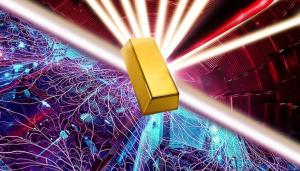
Using the world’s most energetic laser and the world’s most powerful pulsed-power facility, an international research team has derived new pressure scales for gold and platinum at 1 terapascal.
Putting the squeeze on gold and platinum
Scientists have studied the behavior of gold and platinum at pressures near 1 terapascal (TPa) — a trillion pascals — several times the pressure at Earth’s center. They say the new data will provide useful references for researchers studying the exotic behavior of other materials at very high pressures.
At pressures of hundreds of billions of pascals, hydrogen becomes a metal and other materials become superconductors. The extreme conditions that make these extraordinary behaviors possible also make experiments very difficult for scientists. Experiments at these pressures are often conducted within diamond anvil cells that squeeze tiny samples, and it’s not possible to directly measure the pressure experienced by the material inside. Scientists therefore rely on indirect measurements — like density — and reference materials like gold and platinum to determine the pressure inside the cell, which leaves some uncertainty in the value.
Researchers at Lawrence Livermore National Laboratory and Sandia National Laboratories set out to make more-precise measurements of the density of gold and platinum under high pressure so that scientists will be able to make better predictions about other materials. Dayne E. Fratanduono, at Lawrence Livermore, says his group was able to reduce uncertainties in the pressure inferences from 10-20 percent to just a few percent in some cases.

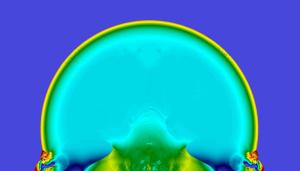
New findings by an LLNL team show how nuclear weapon blasts close to the Earth’s surface create complications in their effects and apparent yields.
Looking inside a blast
A Lawrence Livermore team has taken a closer look at how nuclear weapon blasts close to the Earth’s surface create complications in their effects and apparent yields. Attempts to correlate data from events with low heights of burst revealed a need to improve the theoretical treatment of strong blast waves rebounding from hard surfaces.
This led to an extension of the fundamental theory of strong shocks in the atmosphere, which was first developed by G.I. Taylor in the 1940s. The work represents an improvement to the Lab team’s basic understanding of nuclear weapon effects for near-surface detonations. The results indicate that the shock wave produced by a nuclear detonation continues to follow a fundamental scaling law when reflected from a surface, which enables the team to more accurately predict the damage a detonation will produce in a variety of situations, including urban environments.
The research demonstrates that the geometric similarity of Taylor’s blast wave persists beyond reflection from an ideal surface. Upon impacting the surface, the spherical symmetry of the blast wave is lost but its cylindrical symmetry endures.
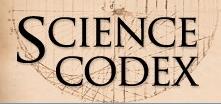
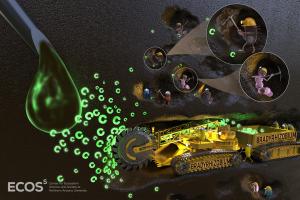
Bacterial "miners" working to process soil nutrients, some more efficiently than others. Bradyrhizobium, one of the three top nutrient processors identified in the study, is shown here. Image courtesy of Victor O. Leshyk/Center for Ecosystem Science and Society, Northern Arizona University
Bacterial work horses
Just a few bacterial groups found in ecosystems across the planet are responsible for more than half of carbon cycling in soils, according to new findings from researchers at Lawrence Livermore and Northern Arizona University.
The new research suggests that despite the diversity of microbial taxa found in wild soils gathered from four different ecosystems, only three to six groups of bacteria common in these ecosystems were responsible for most of the soil carbon use that occurred.
Soil contains twice as much carbon as all vegetation on earth, and so predicting how carbon is stored in soil and released as CO2 is a critical calculation in understanding future climate dynamics. The research team, which included scientists from Pacific Northwest National Laboratory, University of Massachusetts-Amherst and West Virginia University, is asking how such key bacterial processes should be accounted for in earth system and climate models.

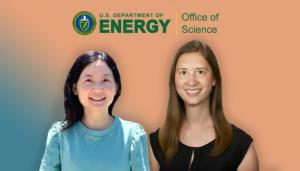
Xue Zheng and Andrea Schmidt recently earned DOE Early Career Research Program awards.
Young and honorable
Two scientists from Lawrence Livermore are recipients of the 2021 Department of Energy’s Office of Science Early Career Research Program award. Andrea Schmidt and Xue Zheng are among 83 scientists nationwide selected for the recognition. Under the program, typical awards for DOE national laboratory staff are $500,000 per year for five years.
The Early Career Research Program, now in its 12th year, is designed to bolster the nation’s scientific workforce by providing support to exceptional researchers during crucial early career years, when many scientists do their most formative work.
Schmidt, a physicist, was selected for her work in high energy density physics, and Zheng, an atmospheric scientist, was selected for her research in aerosol-cloud interactions.
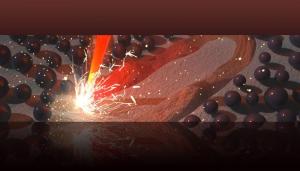
By combining high-performance computer simulations with X-ray imaging of the laser powder-bed fusion metal additive manufacturing process, researchers at Lawrence Livermore National Laboratory and SLAC National Accelerator Laboratory have found a way to negate the formation of pores — tiny holes created under the surface of a build that can initiate cracking in the finished part under stress.
Stressed out
For destressing printed metal parts, "island scanning" may not be the cure-all after all. A research team has found that a method commonly used to skirt one of metal 3D printing’s biggest problems may be far from a silver bullet.
For manufacturers, 3D printing, or additive manufacturing, provides a means of building complex-shaped parts that are more durable, lighter and more environmentally friendly than those made through traditional methods. The industry is burgeoning, with some predicting it to double in size every three years, but growth often goes hand in hand with growing pains.
Residual stress, a byproduct of the repeated heating and cooling inherent to metal printing processes, can introduce defects into parts and, in some cases, damage printers. To better understand how residual stress forms, and how it might be curbed, researchers at Lawrence Livermore National Laboratory, the National Institute of Standards and Technology (NIST), Los Alamos National Laboratory and other institutions closely examined the effects of different printing patterns in titanium alloy parts made with a common laser-based method.
Their results show that a printing pattern often used in industry to decrease residual stress, known as island scanning, had the worst showing among the approaches studied, defying the team’s expectations. The data they produced could help manufacturers test and improve predictive models for 3D printing, which, if accurate, could steer them away from destructive levels of residual stress.





